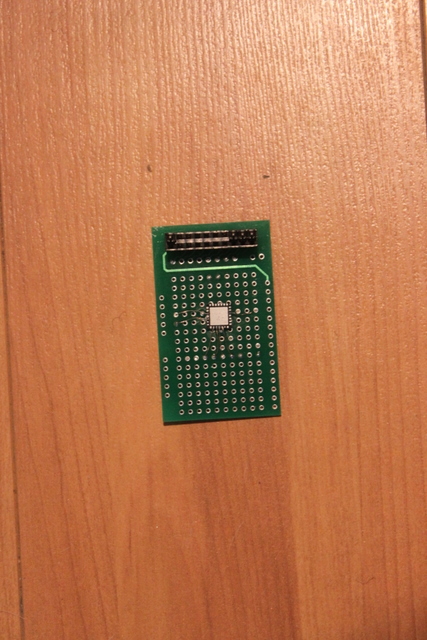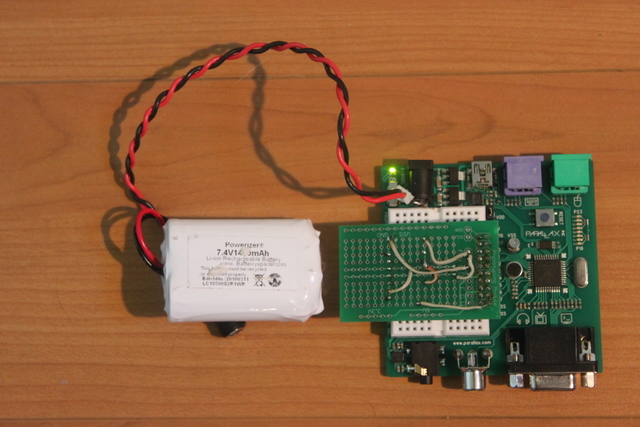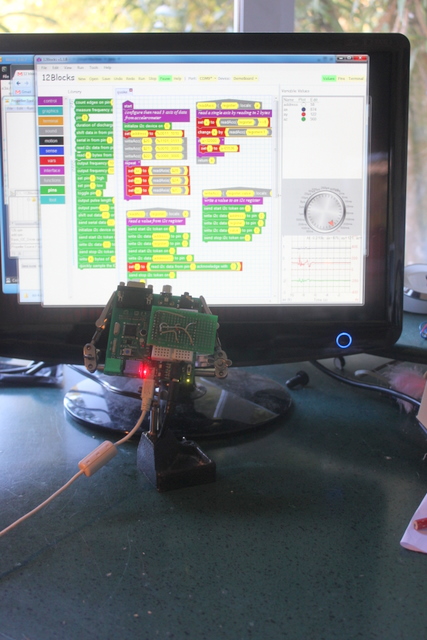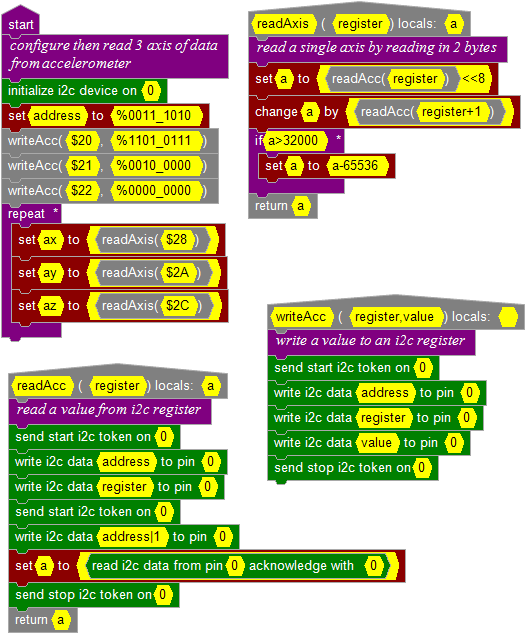Help me monitor earthquakes
Hi,
Here in Christchurch we've had ~300 aftershocks in the last week. A forum member suggested I measure them and I initially responded that "now is not a good time". However, I managed to scrounge something together:
I soldered a 3 axis digital accelerometer (LIS3LV02DQ- same circuit as in DanceBot/Propeller Guide book) to a prototyping board and plugged it into a battery powered DemoBoard. I wrote a program in 12Blocks that uses simple I2C building blocks to configure the accelerometer's internal filters and read measurements for all 3 axis. I double checked the I2C protocol with the logic analyser built into 12Blocks and then monitored the real-time measurements with the "view values" panel.
So far it's still connected to the PC- my next step (after taking care of kids) is to trigger on a quake and only then start writing data into eeprom- so I can turn the PC off.
Any other suggestions? I could monitor other sensors? Or output data with 12Blocks to lcd/tv/vga, maybe hook up a servo to serve as an indicator of the last quake's strength?
Here in Christchurch we've had ~300 aftershocks in the last week. A forum member suggested I measure them and I initially responded that "now is not a good time". However, I managed to scrounge something together:
I soldered a 3 axis digital accelerometer (LIS3LV02DQ- same circuit as in DanceBot/Propeller Guide book) to a prototyping board and plugged it into a battery powered DemoBoard. I wrote a program in 12Blocks that uses simple I2C building blocks to configure the accelerometer's internal filters and read measurements for all 3 axis. I double checked the I2C protocol with the logic analyser built into 12Blocks and then monitored the real-time measurements with the "view values" panel.
So far it's still connected to the PC- my next step (after taking care of kids) is to trigger on a quake and only then start writing data into eeprom- so I can turn the PC off.
Any other suggestions? I could monitor other sensors? Or output data with 12Blocks to lcd/tv/vga, maybe hook up a servo to serve as an indicator of the last quake's strength?






Comments
While living in Taiwan, my first small apartment had a tiny bedroom with a bed inline to the window. I lived in fear that a 3.5 or above quake would ram the bed hard against the wall and I would be flung out through the window by pure momentum! I moved before that happened. What's more interesting, I can detect very small earthquakes without a Propeller chip. During the most recent earthquake disaster in southern China, I was far north and apparently the only person to know it was happening in real time.
I like your idea of using a servo in place of a strip chart recorder. A long attached arm could stylus out the waves at the end of a pencil on a paper pad. Maybe this is a good project for a Boe-Bot or Scribbler to serve as the mechanism to move the stylus along a long strip of paper.
Humanoido
I see you really ran with my suggestion. I didn't expect you to put something together overnight. It looks like I have to look into your 12Blocks. It really made this simple to get a sampling program up and running.
For best results the accelerometer should be firmly in contact with the ground. I have used a concrete pillar block with the accelerometer screwed down on top. This will reduced the "local" noise (kids running through the house,...) Most of the interesting movement will be 100 Hz or lower so a filter set up that and a sampling rate of 200-500 per second should be good.
Happy monitoring. But the kids come first.
Al
He tried to modify the windscreen wiper driven arm, used for the NOAA weather sats, but there was just too much back slack and inertia
I have not had time to check if NZ has actually moved west this time (towards Australia). Do you know? (for others: the last earthquake about a year ago the south island twisted 1ft = 300mm towards Australia)
If you keep the last few second of data in ram, you could include the data from before the trigger point. There might be something interesting happening before the quake reaches the trigger threshold that would be lost if you start recording after the trigger. Some heart monitors use this principle. There is a button to press when a patient experiences unusual heart beats. The recording device keeps the last few seconds of heart data in temporary memory. When the button is pressed the data from the previous few seconds is included in the permanent record along with the data following the button press.
Does a quake cause "ripples" in the air pressure? I think it would be interesting to monitor air pressure.
Do quakes affect the earth's magnetic field? Something like a MicroMag 3-Axis Magnetometer would let you monitor all three axis.
I'm very glad to hear your family is safe.
Duane
First some responses- thanks for the help!
Duane- yes we're safe and kids are back in school and kindergarten-life is slowly returning to normal.
Good idea to measure air pressure and magnetic field. I'll have to look into getting those sensors. Also good idea to keep a circular buffer to store data before the event.
Toby/Miner-I'm still debugging my device so I like to keep it in my office- however, I have it silly-puttied to the floor which is mechanically very close to 2.4m poles encased in concrete. Eventually I'll mount it directly to one of those poles.
Cluso- I don't believe we're closer to Australia- however, I think we're now 4 meters closer to the equator!
Rinks- I had some of these accelerometers lying around- and they're actually very sensitive! I configured it to read a max of 2g's- and I get 12bits of resolution. Maybe I'll try a coil later.
Humanoido- Since these aftershocks will hopefully stop soon, I'll first focus on measuring real quakes and later providing fancier output.
Ok- see attached for the latest 12Block programs which measure quakes and export the data to excel. Also- see the excel spreadsheet which correlates the two quakes with the official data (attached) and graphs the 3-axis of measurements.
The 12Block program to measure a quake:
- initializes the i2c device
- continually increments the time and measures 3 axis worth of data
- runs a state machine which is either in "pre" or "post-trigger" mode.
In the "pre-trigger" state, the device looks for a jolt. If it finds one, it writes the time to eeprom and switches to "post-trigger".
In "post-trigger" state, the device logs data to eeprom and looks for a number of successive calm periods. Only then does it go back to "pre-trigger" state.
The 12Block program to export data to a file:
- reads eeprom
- sets the time if appropriate- or increments it
- uses a new "export" user interface block which monitors variables and writes them to a file- this block will be in the next release of 12Blocks...
I'm still working on improving the trigger to be more sensitive. I also want to sample more quickly. Maybe I'll use an SD card...
Hanno
I did not find where NZ moved towards the equator but I did find where they said a new fault line has been created and the earth has moved (east) 11 feet. I suspect it will be a litle while before all movements are detailed.
In 1969 my HSC (last year in high school in Australia - I was almost 18) in my Geography exam we were told about this hopeless 3rd theory that the continents were on plates that moved. The evidence was such that if you cut out the continents they would go together like a jigsaw. Of course they landed on the moon in July 69 and left measuring instruments there. By early 70 they had proven this hopeless theory was fact.
I will be interested to see what results you can record with the prop and 12 Blocks. I see a new application for school students with Props and 12 Blocks :smilewinkgrin:
Your software is top-notch! Keep cranking
out goodies like 12-blocks :-)
Congratulations on your captures. It looks like they are only about 15 kilometers from you. That's close enough to get some really sharp motion.
As far as "real" quakes are concerned, the accelerometers are probably not suited for distant quakes. The signal-to-noise will limit the range where they can pick up a measureable signal.
I like your silly putty idea.
Al
We're still getting good-sized aftershocks a 4.3 and 4.5 last night. Been busy with other projects so haven't been measuring more.
Cluso- here's what wikipedia says about the canterbury quake: "Though removed from the plate boundary itself, the earthquake likely reflects right-lateral motion on one of a number of regional faults related to the overall relative motion of these plates and may be related to the overall southern propagation of the Marlborough Fault System in recent geologic time."
Looking at the map it appears that at least the major faults go north/south- and I thought the coastal part of NZ slipped north. I did see a video of a helicopter flying along the fault- everything was displaced by 11 feet! Fences, roads, rivers and even a house.
Al-
Measuring distant earthquakes is hard- especially with a houseful of pets and kids. I'll leave that to the experts. I would like to know get a bit more data and then integrate the accelerations to get velocity and position.
Holly- It's hard to crank out multiple projects- I think I'll stick with just ViewPort, PropScope, 12Blocks and TBot for a while...
Hanno
http://www.techlib.com/electronics/seismic.htm
Page 24, Hum detection.
cheers,
Massimo
I particularly liked the "deer repellent" section
But yes, once I find a good place to mount the sensor that doesn't get triggered by kids/trucks on a nearby road, I'll look into complementary technologies that could detect more distant quakes. For now, I like being able to measure the exact acceleration with a calibrated device.
Hanno